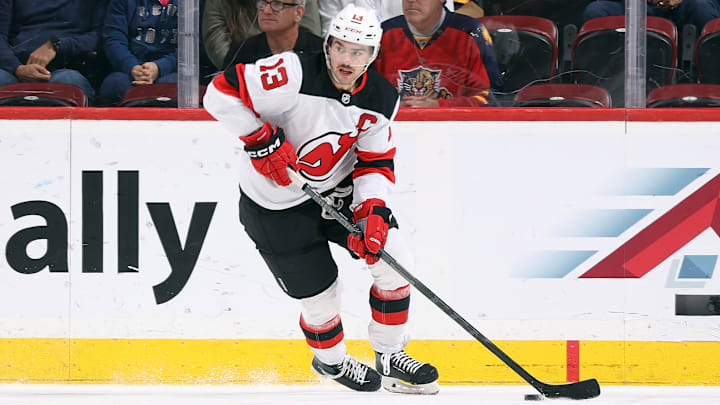We may still be a week and a half away from Thanksgiving, but the Devils just got news that they will surely be thankful for, as they look to put the finishing touches on a roster that will lead them to their first Stanley Cup win in more than 20 years.
NHL insider Elliotte Friedman reported on the Hockey Night in Canada broadcast on Saturday night that the NHL’s salary cap next season may rise well above the artificial 5% growth limit per the CBA. Friedman reported that with hockey-related revenues so high, the cap could rise from $88 million to as high as $95 million to $97 million.
Interesting: @FriedgeHNIC reporting on the broadcast tonight that next year's salary cap could actually be pushed well over the 5% growth limit up to as much as $95M to $97M.
— James Mirtle (@mirtle) November 17, 2024
Right now per the CBA, it's set to go to $92.4 million, but with revenues so high, it makes sense to…
Per the CBA, the max the salary cap should be able to reach next season is 105% of this year’s salary cap, or $92.4 million. But Friedman expanded upon his report during his 32 Thoughts podcast episode released today. He stated that the NHL Players Association head Marty Walsh is on a tour meeting with teams now, and is informing them that the NHLPA will try to negotiate with the NHL to increase the salary cap beyond the CBA’s specified max.
A $97 million dollar cap would represent a 10.2% increase in the salary cap year-over-year, and would be a stunning increase in the flexibility the highest spending teams would have compared to the flat cap era during the COVID-19 pandemic.
The salary cap stayed stagnant during and following the pandemic due to a dip in hockey-related revenue and a debt owed by the players to the owners under the CBA’s escrow structure which ensures a 50/50 split between the owners and the players. But that escrow debt is now paid off, and it looks like the salary cap is about to take off like the Falcon 9 rocket that launched out of Cape Canaveral this afternoon.
Friedman further reported on 32 Thoughts that “the most positive estimates are that in two years, a 50/50 cap will be close to $110 [million].” It’s unclear whether two years Friedman refers to starts from 2024-25, meaning the 2026-27 season that would follow the $95-97 million 2025-26 season (which would be about a 13.4% year-over-year increase), or whether two years means with the 2027-28 season that is three seasons from now (which would mean a smaller 6-7% increase per season).
But no matter how it shakes out, an increase from $88 million now to $110 million in the near future would mean GMs would have a 25% increase in the amount of money they can spend on their roster.
What does this mean for the New Jersey Devils? Well, they’re exceptionally well-positioned to benefit from the spike in the salary cap—perhaps moreso than any other team.
The team is financially healthy according to their franchise valuation from Forbes, ranking 6th in the NHL with $240 million of hockey-related revenues. And it’s shown on the roster, with the owners opening their checkbooks for big extensions for Jesper Bratt (8/$7.88 mil) and Timo Meier (8/$8.8 mil). They also have Jack Hughes signed through 2029-30 at a bargain $8 million, and a #1 caliber defenseman in Hamilton signed through 2027-28 for $9 million.
So the Devils are well-positioned to spend up to the increased cap, and they have the incredible luxury of having most of their key players locked in long-term at rates based on the flat cap era.
The only two marquee names remaining to be signed past the 2026-27 season are captain Nico Hischier and Luke Hughes. Nico’s next contract will set him up to be the team’s highest paid player, especially if his offensive breakout continues. And as we have previously noted, the extension for Luke Hughes will be pricier than most fans think, especially as the salary cap continues to rise. Much of Ondrej Palat’s expiring contract after 2026-27 will likely be earmarked to pay for Nico’s pay raise and Luke’s first big contract.
But even factoring in the paydays for Hischier and Hughes, the Devils will still have plenty of cap flexibility to continue to supplement their championship-caliber core into the back half of the decade.
They seem to have their D-core sorted for the next three years—though if Jonathan Kovacevic continues to play like he has, he’ll be due a steep raise on the sub-league-minimum salary he is making this year. They’ll need to find a long-term goalie solution once Markstrom and Allen’s deals expire. But they should also be real players for improvements to their forward core in upcoming UFA cycles, and could even be in the hunt for stars like Nikolaj Ehlers and Brock Boeser.
Put simply, the news that the cap is going up should truly excite Devils fans, as it should be easier than ever for GM Tom Fitzgerald to continue to add talented players to this Devils roster.
